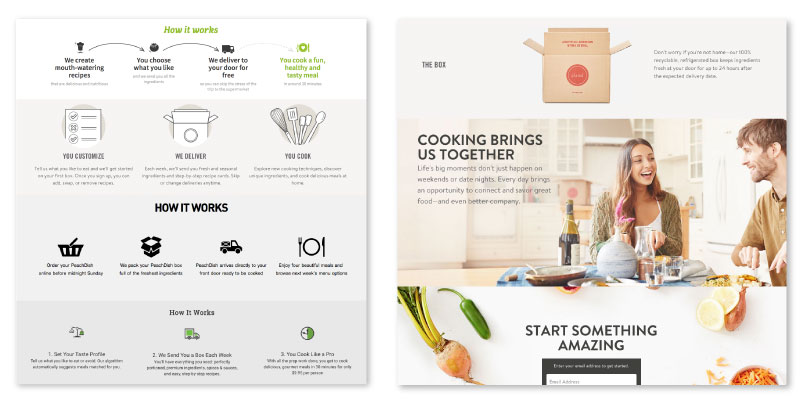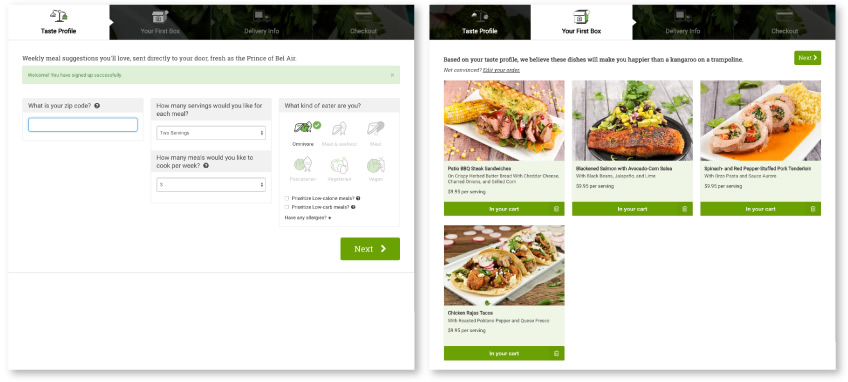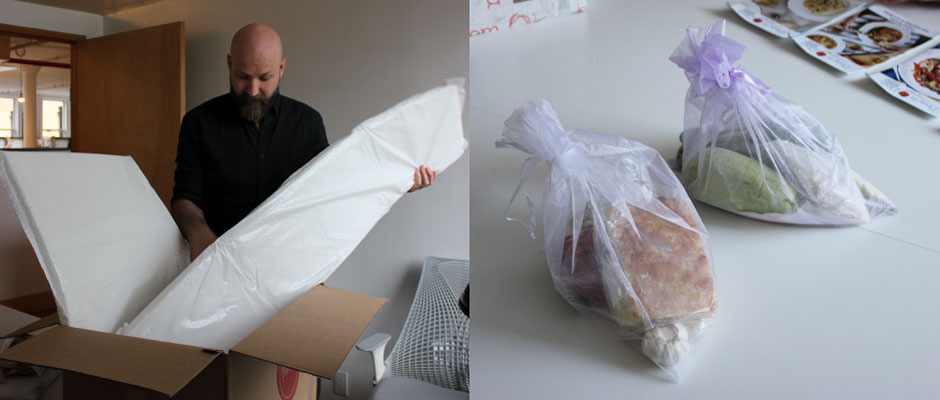Context
Forget the cronut. And the ramen burger. Meal kit services have quickly become an unstoppable U.S. food phenomenon.
Since the idea arrived from Sweden in 2012, brands have carved out an online market predicted to take a $5 billion bite out of America’s $1.2 trillion food industry.1 Blue Apron, the leading meal kit brand in the U.S., was recently valued at a whopping $2 billion2—an impressive figure made more impressive by the fact that the company has only been around for three years. Fueling the rise of these services is a booming e-commerce culture; busy urbanites who want to cook, but have no time to shop or plan; and the evergreen appeal of farm-to-table dining.
Oh, and something about reducing the soul-destroying amount of perfectly good food thrown away in the U.S. each year—over 30% of groceries.3 Gulp.
Challenge
As fans of the underdog, we compared four brands that aren’t Blue Apron to see which delivers the best experience online and in the kitchen. To really turn up the heat, brands only had one box and one impression to make a connection with our judges.
Who Will Win Our Battle of the Boxes?

Established:
2012, New York
Brand narrative:
Shared moments delivered to you.

Established:
2012, Germany
Brand narrative:
Fresh flavor delivered every week.

Established:
2013, Chicago
Brand narrative:
Everybody can cook like a chef.

Established:
2013, Atlanta
Brand narrative:
Southern-inspired kitchen adventures.
INSIGHT
Before we tell you who won in our full Field Notes report below, here are the top takeaways we found between signing up for a box and—ugh—washing the dishes.
WEBSITE
COOKING WITH LOVE WORKS

How it works is identical across the board, but Plated played up the most important ingredient: shared moments.
Looking at the websites side by side, we found good designs but mostly undifferentiated content. Every brand provided bite-sized instructions on how the service works. Every brand showcased appetizing photographs of current and future recipes. And every brand had almost identical messages related to solving the dinner conundrum—from “eating well made easy” to “cook faster, easier, healthier.” Plated and PeachDish, however, stood out with a richer story. They created an intimate connection by evoking the added value of their meals: shared moments with loved ones.
HOT: Plated and PeachDish’s emotive connection to cooking.
COLD: Home Chef’s category-only language.
CHECKOUT
BEST SERVED LOGICALLY

Home Chef made us salivate over the dinners before making us pull out the credit card. That’s the way to do it.
Every brand had a different checkout process, but we felt that only one got it right. Home Chef provided an intuitive user flow that reflects ordering food in real life: start with your dietary preferences, choose meals from a menu (with mouthwatering photos), and pay as you leave. Logical. Simple.
At the frustrating end of the spectrum was HelloFresh. Oddly, we were not able to see what our box would contain before providing our credit card details. This made us double back a few times, scratching our heads and feeling hesitant to pay for a box of mystery meals.
HOT: Home Chef’s natural user flow.
COLD: HelloFresh’s awkward checkout.
SOCIAL MEDIA
GET THE INGREDIENTS RIGHT

Plated served up delicious social treats for us to enjoy.
Food and social media go hand in hand, so we were interested to see if our four brands did more than just provide endless photo streams of good-looking meals. Plated stood out to us for a couple of reasons. First, their social media presence reinforced a brand narrative of “shared moments.” For example, a simple but effective use of #TBT captured childhood photos of staff members enjoying family moments with food. Second, Plated have a strong YouTube presence, extending the cooking experience with tutorials and life hacks that were also shared across platforms.
HOT: Plated and PeachDish consistently on-brand.
COLD: Home Chef’s mixed messages.
BOXES
DELIVERING MORE THAN MEALS

Delightful surprises from PeachDish, pits in our stomach when Home Chef arrived.
An exciting moment in the meal-kit delivery experience is, of course, the arrival of the box. It’s a valuable chance for brands to deepen relationships with timely messages and thoughtful surprises. So it felt like a missed opportunity when some brands simply packaged up ingredients without so much as a “have a nice day.” And when a box arrives looking a little worse for wear, you begin to wonder if eating dinner-by-mail was such a good idea. Only PeachDish made the extra effort to delight in more ways than one, delivering a brand you can love as much as its meals.
HOT: PeachDish’s extra chocolates.
COLD: Home Chef’s banged-up box.
COOKING
CREATIVE EXPERIENCES MATTER

The cooking squad is assembled.
Charting new culinary territory was definitely a fun experience and a strong positive for every brand. We loved trying new recipes. But we found there’s a fine balance between cooking a tasty meal and getting your money’s worth. All of us agreed that the right amount of creativity to challenge and advance your expertise was an essential ingredient to feeling engaged and inspired. While HelloFresh was the only brand that indicated levels of difficulty with each dish, we wished there were ways to customize meals based on our confidence in the kitchen.
HOT: Home Chef’s surprisingly creative meals.
COLD: Plated’s surprisingly boring meals.
SUSTAINABILITY
RESPONSIBLE PACKAGING TASTES BETTER

Getting a foam mattress as insulation is not the best of presents. Beautiful mesh bags from PeachDish were a nice suprise, though.
Packing and shipping perishable ingredients across the country is no small feat. Ice packs, insulation and leak-proof bags combine to keep meals fresh in a cardboard box for close to 24 hours. A weekly box of multiple meals, often with individually wrapped garnishes, added up to more packaging than we knew what to do with. We were surprised that for services geared toward food waste reduction, a program or guidance for recycling was not front and center. While some used packaging in smarter ways than others, we felt brands could do a better job of communicating and implementing green practices.
HOT: PeachDish’s reusable bags.
COLD: HelloFresh’s Styrofoam box.
Full Note
Download the full Field Notes to discover which brand we’d order again and why, as well as more tasty details about each experience.

